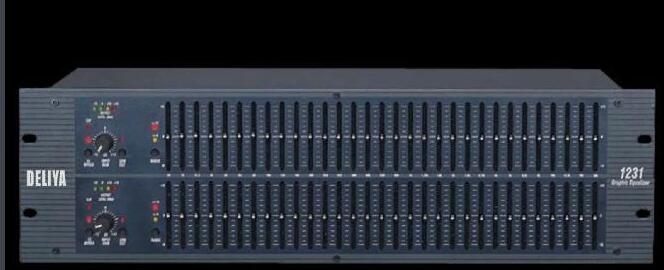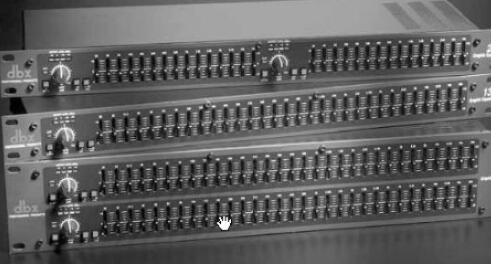The equalizer (Equalizer) is an electronic device that can individually adjust the amplification of various frequency component electrical signals. It compensates the defects of loudspeakers and sound fields by adjusting the electrical signals of various frequencies, and compensates and modifies various sound sources. And other special effects, the average equalizer on the mixer can only adjust the frequency, frequency, and frequency of the three sections of electrical signals. In a communication system, inserting an equalizer in a tying system can reduce the effect of inter-code interference.
This article first answers what the equalizer digital represents, and then elaborates on how to adjust the equalizer, which is detailed in terms of balancing the pleasing sound and the tone characteristics of the frequency.
The principle of equalizerEqualizer In a communication system, a component that corrects the amplitude and frequency characteristics and the phase-frequency characteristics of a transmission channel. The sine wave of frequency f is sent to the transmission channel. The characteristic that the ratio of the output voltage to the input voltage changes with f is called the amplitude-frequency characteristic. It is simply called the amplitude-frequency characteristic; the phase difference between the output voltage and the input voltage varies with f. Known as phase frequency characteristics, referred to as phase frequency characteristics. The signals transmitted by various transmission channels generally consist of some components of different frequencies. In the signal band range, if the amplitude frequency characteristic of 1 channel is a constant value; the characteristic of 2 phase φ changing with f is a straight line, which can be written as
¢(f)=2πft+θ, t is a constant; 3θ (referred to as phase cut) is equal to nπ, n=0,±2,±4,..., the signal waveform is not distorted by transmission. Condition 1 allows different frequency components to have the same output-to-input amplitude ratio after transmission, and conditions 2 and 3 cause them to have the same time delay. However, the actual channel often does not meet the above conditions, so the signal is distorted. If the distortion exceeds the allowable amount, the equalizer is used to correct the channel characteristics.
Balanced requirements are related to the nature of the signal. Since the human ear is insensitive to phase, when transmitting an analog telephone signal, only the amplitude-frequency characteristics of the channel are required. When transmitting a television signal, there are requirements on the amplitude and phase frequency characteristics of the channel, otherwise the picture is distorted. When the digital signal is transmitted in the baseband, the amplitude and phase frequency characteristics are required, because the waveform distortion will generate inter-symbol interference and increase the bit error rate. When the digital signal carrier is transmitted, the phase-frequency characteristic of the channel is not required to be intercepted. This is because the phase reference is not needed when receiving the digital frequency modulation signal, and the phase reference can be solved using the carrier recovery circuit when receiving the digital phase modulation signal. In this way, only the requirements of the amplitude-frequency characteristics and the delay-frequency characteristics of the carrier transmission are required.

The number represents the value of the frequency band adjusted by the putter, and the fader adjusts the sound volume of the frequency band. Next we understand what each band value means:

31 Superbass, 62,125 bass, 250-500 midrange bass, 500-2K midrange, 2K-4K midrange, 8K treble, 16K treble.
Detailed explanation of the equalizer adjustment methodSubwoofer: 20Hz-40Hz, sounds strong and powerful when appropriate. Controls the sound of thunder, bass drums, organs, and bass. Excessive promotion can make the music cloudy.
Bass: 40Hz-150Hz is the basic part of sound, and its energy accounts for 70% of the entire audio energy. It is an important component of the performance of music style.
When appropriate, the bass is well-relaxed, and the sound is full and soft. When the sound is not enough, the sound is thin. At 150 Hz, the sound rises when the lift is excessive, the brightness decreases, and the nasal sound increases.
Bass: 150Hz - 500Hz, is the structural part of the voice, vocal in this position, when the lack of singing voice will be submerged in music, the sound is soft and powerless, when properly promoted will feel strong and strong, improve the strength and loudness of the voice. Raising the bass will make the bass harder, and over-promote 3-6dB at 300Hz. If you add _ up reverb, it will seriously affect the clarity of the sound.
Midrange: 500Hz-2KHz, containing the low harmonics and overtones of most musical instruments. It is the characteristic sound of snare and percussion instruments. The sound is clear and bright when appropriate; When over-escalated, it will produce a telephone-like sound.
Neutral: 2KHz-5KHz, which is the characteristic sound of the string (the sound of the bow and the string of the string is played, and the sound of the finger of the playing string touches the string). The penetrating power of the sound decreases when it is insufficient, and it masks the recognition of the language syllable when it is too strong.
Treble: 7KHz-8KHz, is the frequency that affects the sense of sound layering. Excessive promotion will make the sound of piccolo and flute prominent, and the tone of the language will increase in tone and tone.
Extremely high: 8KHz-10KHz
When appropriate, the metal feel of the triangle and the Li* is high, and the rhythm of the sand clock is clearly visible. Excessive lifting will make the sound unnatural and it will burn the high frequency unit easily.

Balanced and pleasant sound should be
Below 150Hz (bass) should be plump, soft and elastic;
150Hz 500Hz (middle bass) should be thick, strong, and turbid;
500Hz - 5KHz (middle and high) should be bright and thorough and not stiff;
More than 5KHz (treble) should be slender, smooth but not sharp.
When the entire frequency response is flat, the sound is naturally full and flexible, and the level is clear and pleasant. When the frequency response is in multiple peaks and valleys: the sound is rough and turbid, the high-pitched hair is harsh, and there is no layered sound reinforcement and feedback whistle can easily occur.
Frequency characteristics of sound
30-60Hz dull If there is no loud loudness, the human ear can hardly feel it.
60 ~ 100Hz heavy around 80Hz can produce a strong "heavy" effect, high loudness does not give a comfortable feeling, can give people a strong stimulating effect.
100~200Hz fullness
200 ~ 500Hz force easily cited | from the boring sound of boredom.
500 ~ 1KHz bright 800Hz near the increase of 10dB, will obviously produce a sense of confusion, a sense of narrow.
1K~2KHz Translucent 2800Kz has the highest brightness in the vicinity.
2K~4Kz sharp 6800Hz forms wailing, sharp feeling. 4K~8Kz crisp 3400Hz easily cited |
8K~16Kz slender 7.5KHz sound clear and slender.

Antenk mini usb:The small USB socket found on digital cameras, external hard drives, USB hubs and other equipment. Mini USB is much smaller than USB Type A and B but twice as thick as Micro USB (see illustration below).
MINI USB, also known as Mini USB, is a USB interface standard. USB is the abbreviation of universal serial bus in English, which means "universal serial bus" in Chinese. It is a technology developed for data transmission between PC and digital devices. Standard USB, MINIUSB and microusb have become the most common USB interfaces. Compared with standard USB, MINIUSB is smaller and suitable for small electronic devices such as mobile devices.
Mini USB is divided into a type, B type and ab type. Minib type 5pin interface is the most common interface. Due to its excellent anti misplug performance and small size, it is gaining the favor of many manufacturers. This interface is widely used in card readers, MP3, digital cameras and mobile hard disks.
Mini USB a, B connectors and their contacts (not drawn to scale) Mini USB Connector contact function
1 VBUS (4.4–5.25 V)
2 D−
3 D+
4 ID
5 grounding
The ID foot is only used in OTG function. The Mini USB interface is divided into mini-a, B and ab interfaces. If your system is only used as a slave, then use the B interface. The system controller will judge the level of the ID pin and determine what kind of device is inserted. If it is Gaoping, it is the B connector. At this time, the system will do slave mode. If the ID is low, it will be a interface. Then the system will use HNP dialogue protocol to decide which is the master and which is the slave
OTG is the abbreviation of on the go, that is, OTG technology is to realize the data transmission between devices without host. It is mainly used in the connection between different devices or mobile devices for data exchange. For example, the digital camera is directly connected to the printer, and through OTG technology, the USB port between two devices is connected to print out the photos taken immediately; the data in the digital camera can also be sent to the mobile hard disk of USB interface through OTG, so there is no need to carry expensive memory card or carry a portable computer for field operation.
Except for pin 4, other interface functions of Mini USB are the same as those of standard USB. The fourth needle becomes the ID, which is connected to the fifth needle on the mini-a, and can be suspended in the mini-b or connected to the fifth needle.
Mini USB
ShenZhen Antenk Electronics Co,Ltd , https://www.antenksocket.com
